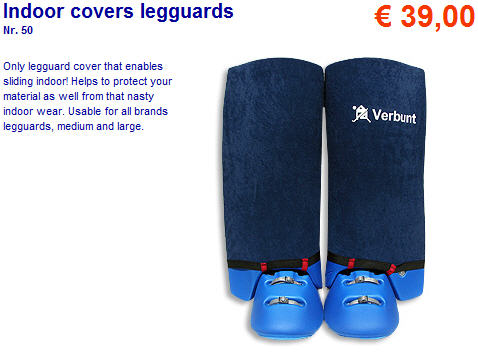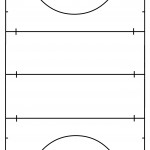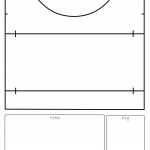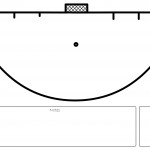The removable style of arm pads, like Obo’s design, makes it possible and easy to customise protection desired to the goalkeeper’s preferences according to their style of play. Rather than wearing both arm pads for full protection, there are a number of different combinations to allow greater flexibility in fluid saving movements, or that extra mobility to make reflex saves when reacting to an unexpected change of angle, like during a tip-in deflection. Suiting the goalkeeper’s style of save making, the different set-ups give various advantages to aid in their shot stopping abilities.
Right arm padded only
This concept has the goalkeeper removing the arm pad from the left arm, for full movement (useful for defending against well placed quick shots, like fast drag flicks and hard, well struck shots), but keeping the right arm padded for full protection. It is based on the theory of the right arm being used to block shots (being placed behind the stick to cover, on raised shots, if the ball is missed) and spending most of the time on the floor, so therefore needs protecting – when going down in a log, or sliding out to tackle/block, only the right arm will be on the ground. Dropping the arm completely down to be flat and fully connected with the pitch, for covering the shot along the floor opens up the gaps above and below the elbow, which would not be protecting by elbow pads. The arm pad therefore provides full protection, when fully extending the arm on a low save.
With the right side therefore not needing to be so ‘reflexive’ (bringing the glove/stick in to block), only the left arm is uncovered. Even elbow pads can be somewhat restrictive (especially if they are tightly strapped over the arm), so to gain full movement in reflex saves to the glove side, the glove arm is not protected to allow total freedom for the arm and elbow joint muscles to move. This way, the goalkeeper can actively make unrestricted athletic glove saves reaching across, without the stiff arm pad to limit movement.
This style of upper body protection has been fairly popular with the crop of New Zealand’s international goalkeepers; Paul Woolford used it during his whole international career, as did his replacement Kyle Pontifex for a short while. It is quite popular in Germany, with a number of Bundesliga goalkeepers using the set-up, as well as being used by Dutch keepers. There are also a couple of keepers in the Spanish male Divisio D’Honor (like the Club de Campo goalie) using it for its gained movement to the glove side.
It is currently growing in popularity in South America as the general method of protection. Argentina’s number 1 women’s keeper, Maria Belen Succi, and the second men’s keeper both use the set-up, whilst it is growing in use in Chile; with their men’s keepers using it. It is also popular in the junior ranks; with the junior Argentinian goalkeepers using it in the recent Junior World Cups.
Right arm pad, left elbow
With arm pads being bulky and weighted, the goalkeeper can often be handicapped by the thick padding on the left arm, needing to be able to move around more fluidly for reactive glove saves in the reflex style of field hockey goalkeeping. Requiring extra manoeuvrability to power away rebounds in a directed clearance away from the body, arm pads don’t always give optimum movement, so an elbow pad is worn instead. However, the left arm can still be vulnerable to dodgy shots because of
goal mouth scrambles and close-in tips; going down athletically to block with the body, so the elbow pad is often worn to protect the bone and surrounding joints.
The elbow pad on the left arm offers a more suitable alternative to an arm pad on the glove side; protecting the elbow from a shot without fully limiting the ability for reflexive and reactive saves around the body and sides. With the elbow covered, only the forearm and the bicep area above the elbow (which is fleshy and less at risk to breaking, if a shot did pin the goalkeeper there) are in potential danger, thus ensuring the goalkeeper is protected enough for game action. The arm pad left on the right arm enables the goalkeeper to happily make more angle and ‘body’ saves; using it for blocking with an active barrier, knowing the arm is potentially well protected from harm.
This method is quite rare, with not too many goalkeepers using it. Currently, the Austrian mens’ goalkeeper was seen using it at the recent Rabo EuroHockey Nations Championships tournament (for World Cup qualification), whilst there is at least one goalkeeper in the Irish national league using the arm pad and elbow set-up. It is also taught and slightly popular in Australia; Stephen Mowlam was known to wear it when logging in a short corner defence.
Both elbows
An alternative method to wearing a full arm pad, which enables freer movement at the wrists and shoulders (the turning points of the arm, for those ‘twitch’ actions to make a last moment reaction save, which are often infringed with arm pads too stiff to provide the full range of amount), giving the greatest amount of freedom, bar wearing nothing, is to wear elbow pads on both arms. In comparison to wearing full arm padding, the reduced amount of coverage also results in decreased weight for the goalkeeper to carry, meaning they are not as weighed down as much for moving into reaching saves. The goalkeeper is not completely infringed from moving the arm fully, for reflex saves, and is also covered against the chances of being in the vicinity.
Elbow pads are worn purely for protective purposes, as the school of thought teaches the need to protect the bone (which would put the goalkeeper out of action, if damaged), as well as looking after the muscles: the pads are there to protect the bones, from a direct hit, whilst looking after the muscle joints surrounding the elbow, on the basis that continually landing on the area after a save (when diving or landing a jump/high dive) can result in long lasting damage – causing an ailment similar to “tennis elbow”. Sometimes, they are often simply used to cover bare flesh, with the chance of ‘skinning’ the elbows on a rough sand based pitch.
When standing up against shots, and bringing the arms in to passively block, like against a deflection, where the arms are exposed, the goalkeeper is putting themselves in danger. Elbow pads often have added forearm padding, helping protect the vulnerable bones surrounding the wrist, in case of taking a shot there; furthering the confidence to go down low against hard strikes that would otherwise be dangerous. With the elbows fully protected, the goalkeeper can comfortably go down for barrier saves and block slides with the confidence of being safe from harm, as well as having the elbow ‘backed up’ for blocking a stick side shot, with the chance of it skimming past.
This set-up is popular in Britain, and with the common school of thought with goalkeeper coaches; it is seen quite a lot in the domestic regional and national leagues, as well as at county and junior level. International English goalkeepers George Pinner and Becky Duggan are among the many examples. Welsh, along with Irish goalkeepers, also find it popular; like David Harte, Ireland’s no 1. However, it is not just used in the British Isles: Klaas Veering, the goalkeeper from Amsterdam H&BC (who has been capped internationally) uses this; matching his style for stand-up reaction saves and blocking low with barriers. There are also a few goalies in the Bundesliga who use the set-up, with Kristina Reynolds (female German international, who played as the first choice keeper in the 2008 Beijing Olympics) wearing two elbow pads as well.
Right arm elbow, left unprotected
For stand-up reflexive style keepers who hardly ever go down to ground for a save and prefer to bring their gloves in to block shots on either side of the body, they tend to use a set-up, where only the right elbow is padded, to enable as much movement as possible, without maximising the risk levels. With the left arm left needed for extra movement for those athletic, reflex and dramatic saves against tough drag flicks, only the right elbow is padded up. In case of being hit there, an elbow pad is worn; reinforcing the coverage behind the stick, for stick saves (in case the shot is missed). This also helps protect the joints and muscles, when diving down to the stick side; limiting the chances of damaging the elbow when landing, as well as the chance of getting hit there. Again, with the left arm free, the goalkeeper has full movement on glove saves, for using the glove in all positions around the body in shot blocking.
The main chance of being hit on the right elbow is when going down on the play; diving, sliding out to tackle or going down to block a low shot, with barrier style saves. The elbow pad also gives protection to the elbow when sliding; covering against the chance of skidding along the pitch surface when sliding on the right. It is also possible to safely go down against a shot with a ‘long barrier’ shape for barrier saves; tucking the right arm more into the body to give extra protection (with the left arm also brought down to hip height, and behind the body, to protect the fully exposed arm), to bring the exposed area of the arm (upper arm and forearm) away from the shot; so an elbow pad provides sufficient protection, covering the vulnerable bone.
This style is fairly popular in Holland; Jaap Stockman, the young prodigy of HC Bloemendaal and the Dutch national team uses it to protect his right side, whilst leaving the glove arm free for reflex saves; the main element of his deep positional, reactive style. It is also fairly popular in Belgium, with national keeper David van Ryssleberghe is a good example. England national goalkeepers James Fair and Nick Brothers both use the set-up, for its reflex style elements, and reacting athletically against well placed drag flicks. Ireland’s second choice international keeper Iain Walker, use of it for its reflexive purposes, shows how its popularity in western Europe is growing. Kyle Pontifex (New Zealand’s new first choice) has been using this set-up since 2007 and the BDO Champions Challenge, again, for its increased freedom of movement for reflex style saves. Juan Manuel Vivaldi, Argentina’s prominent number 1 men’s goalkeeper, who has also recently been playing in the Hoofdklasse (Holland’s premier league) also uses it, for these reasons.
Which to use?
The combination you use for arm protection will depend on the way you play: if you spend more time standing up, patiently waiting to react to the shot, then you will normally ‘pad down’ more to allow greater use of your reflexes, whilst if you prefer to bring your body into play to get in front of the ball, then you are going to cover up more. You should also be aware of the safety aspects relating to reducing protection to allow increased movement for save making; given that you are exposing vulnerable areas by losing protection in order to gain advantages of increased movement, you should be aware of plays in the game that can leave you in danger, like close-in shots with the arms brought, where you could risk a fracture if you ended up being hit on the uncovered bone.
The older and more experienced you get, the better you are to experiment, knowing how you play and the ways you block certain types of shots, and can therefore make well thought out decisions concerning your safety.







